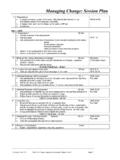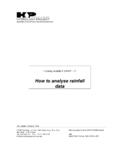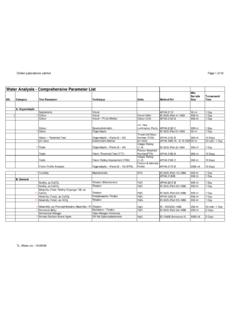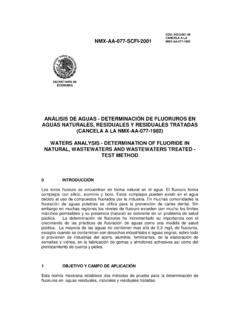Transcription of How to measure Fluoride: SPADNS Spectrophotometric Method
1 World Bank & Government of The Netherlands fundedTraining module # WQ - 36 How to measure Fluoride: SPADNS SpectrophotometricMethodNew Delhi, February, 2000 CSMRS Building, 4th Floor, Olof Palme Marg, Hauz Khas,New Delhi 11 00 16 IndiaTel: 68 61 681 / 84 Fax: (+ 91 11) 68 61 685E-Mail: Consultants BV & DELFT HYDRAULICS withHALCROW, TAHAL, CES, ORG & JPSH ydrology Project Training Module File: 36 Measurement of Version 23/02/00 Page 1 Table of contentsPage1 Module context22 Module profile33 Session plan44 Overhead/flipchart master55 Evaluation sheets126 Handout147 Additional handout188 Main text20 Hydrology Project Training Module File: 36 Measurement of Version 23/02/00 Page 21.
2 Module contextThis module concerns measurement of fluoride by SPADNS Method . Other related modulesare listed designing a training course, the relationship between this module and the others,would be maintained by keeping them close together in the syllabus and place them in alogical sequence. The actual selection of the topics and the depth of training would, ofcourse, depend on the training needs of the participants, their knowledge level and skillsperformance upon the start of the water quality conceptsWQ - 01 Discuss the common water qualityparameters List important water quality chemistry conceptsWQ - 02 Convert units from one to another Discuss the basic concepts ofquantitative chemistry Report analytical results with thecorrect number of significant aquatic chemistry.
3 Solubility equilibriaWQ 29 Explain the principles of chemicalequilibrium Define solubility product and explainhow this relates to water qualityassessment Define the octanol-water partitioncoefficient and explain how thisrelates to water quality of ion selective probesWQ - 33 Precautions required in use of ionselective SpectroscopyWQ - 34 Understand the principles ofabsorption spectroscopy Explain the use of absorptionspectroscopy for chemical analysesHydrology Project Training Module File: 36 Measurement of Version 23/02/00 Page 32.
4 Module profileTitle:How to measure Fluoride: SPADNS Spectrophotometric MethodTarget group:HIS function(s): Q2, Q3, Q5, Q6 Duration:One lecture session of 30 min., one laboratory session of 120 one concluding session of 30 :After the training the participants will be able to: measure fluoride by SPADNS Method appreciate interference by saltsKey concepts: SPADNS Method InterferenceTraining methods :Lecture, LaboratoryTraining toolsrequired:Board, flipchart, OHS, chemical laboratory, spectrophotometerHandouts:As provided in this moduleFurther readingand references: Chemistry for environmental engineers - C.
5 N. Sawyer, P. & G. F. Parkin, McGraw - Hill, Inc., 1994 Standard methods for the examination of water andwastewaters, AWWA, 19th edition, 1995 Hydrology Project Training Module File: 36 Measurement of Version 23/02/00 Page 43. Session planNoActivitiesTimeTools1 Preparations Reagents as described in SAP Samples: A Tap water,B Tap water IL + Stock fluoride 50 mLC Sample B 500 mL + Na2SO4 1gD Sample B 500 mL + NaCl : Describe significance of fluoride Ask participants if they know of areas where fluoride is aproblem10 Method Describe briefly the Method , interferences and the aim ofthe experiment Ask participants to read the SAP20 Divide the class in groups of 2 to 3 persons Provide the stock fluoride solution and ask each group toprepare atleast 4 standards While the participants are preparing standards.
6 Demonstrate the working of the spectrophotometer to eachgroup separately. Ask the participants to complete the experiment120 minLaboratory5 Report and wrap up Ask the participants to prepare their reports Discuss results30 minHydrology Project Training Module File: 36 Measurement of Version 23/02/00 Page 54. Overhead/flipchart masterOHS format guidelinesType of textStyleSettingHeadings:OHS-TitleArial 30-36, with bottom border line (not:underline)Text:OHS-lev1 OHS-lev2 Arial 24-26, maximum two levelsCase:Sentence case.
7 Avoid full text in :Use occasionally and in a consistent wayListings:OHS-lev1 OHS-lev1-NumberedBig for definite series of steps. Avoidroman numbers and :None, as these get lost in photocopying andsome colours do not reproduce at of a table will ease horizontal alignmentover more lines (columns)Use equation editor for advanced formattingonlyHydrology Project Training Module File: 36 Measurement of Version 23/02/00 Page 6 Introduction (1) Fluoride is present in most natural waters Concentrations vary from to 100 mg/L but less is much more common Some groundwaters have very high concentrations of fluoride In India, at some locations in Andra Pradesh and Tamil Naduthe concentration of fluoride can reach 10 mg/LHydrology Project Training Module File: 36 Measurement of Version 23/02/00 Page 7 Introduction (2) Fluoride is both beneficial and toxic to humans.
8 - At low concentrations ( mg/L) it prevents dental caries- At high concentrations (> mg/L) it causes skeletal fluorosis- At intermediate concentrations it causes mottling of teeth The Indian standard prescribes the limit for fluoride for watersto be used for drinking as mg/LHydrology Project Training Module File: 36 Measurement of Version 23/02/00 Page 8 SPADNS Spectrophtometric Method Fluoride reacts with certain zirconium dyes to form acolourless complex and another dye The dye becomes progressively lighter as fluorideconcentration increases Absorbance is measured at 570 nm Prepare calibration curve using absorbance values for knownstandards Read fluoride values for the samplesHydrology Project Training Module File.
9 36 Measurement of Version 23/02/00 Page 9 Interference Substance causing mg error at mg F-/LSubstanceConc. mg/L Type of errorAlkalinity5000(-)Al3+ (-)Cl-7000(+)Fe2+10(-)SO42-200(-)Hydrolo gy Project Training Module File: 36 Measurement of Version 23/02/00 Page 10 Measurement of Fluoride Aim:- To determine the concentration of fluoride in different samples ofwater- Study the interference caused by Na2SO4 and NaClSampleSourceProbable concentrationALow TDS water0-1 mg F-/LBLow TDS water2-3 mg F-/LCSample B + Na2SO42-3 mg F-/LDSample B + NaCl2-3 mg F-/LHydrology Project Training Module File.
10 36 Measurement of Version 23/02/00 Page 11 Report The aim of the investigation The results that you have produced The effect of the added salts The need for distillation of samples The likely effect on human health if this water is drunkHydrology Project Training Module File: 36 Measurement of Version 23/02/00 Page 125. Evaluation sheetsHydrology Project Training Module File: 36 Measurement of Version 23/02/00 Page 13 Hydrology Project Training Module File: 36 Measurement of Version 23/02/00 Page 146.













